This was published 5 months ago
Why we cop threats in the search for information you deserve to know
The Age backs tough, difficult journalism. I feel intensely privileged to be a journalist working for you – our readers.
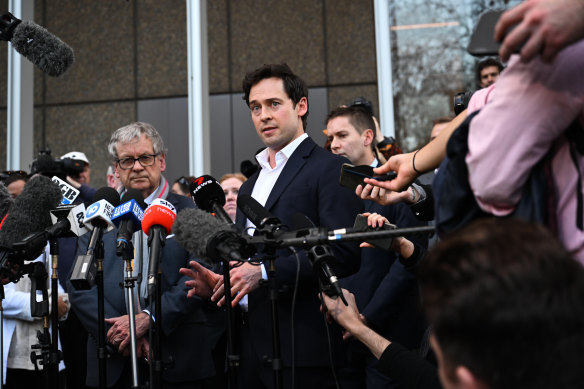
Nick McKenzie, with colleague Chris Masters (left) speaks to the media after the Ben Roberts-Smith defamation case.Credit: Janie Barrett
When I tried to tally up the death and other violent threats I’ve copped while working as an investigative reporter for The Age, I quickly lost count. Most come from the mad or sad, and can be ignored. If you’re not annoying people, you’re not working hard enough, an old editor once told me.
The threats that come from the truly bad, I can count on one hand. Twice I’ve had to clear out of my house on the advice of the police. Looking back, what I remember about both occasions is not the threat, but the way The Age kicked into gear to offer support, security, a coastal house to lie low. Deputy editor Mathew Dunckley, who is built like a greyhound, volunteered to supplement law enforcement and private security assistance with his own night-time patrols. When it was safe, The Age supported me to keep reporting.
It gives an insight into the unique role The Age plays in the life of Victoria and Australia, especially when it comes to investigative reporting. The paper is unafraid to shine a light when it’s needed, not only for our subscribers and readers, but for something bigger. Call it the greater good, or the public interest. However you define it, it defines the best of our work.
But when I write about The Age, it isn’t only about our journalistic values, or the content, or whether the paper thuds on your doorstep, or arrives on your phone. The paper is made by its people.
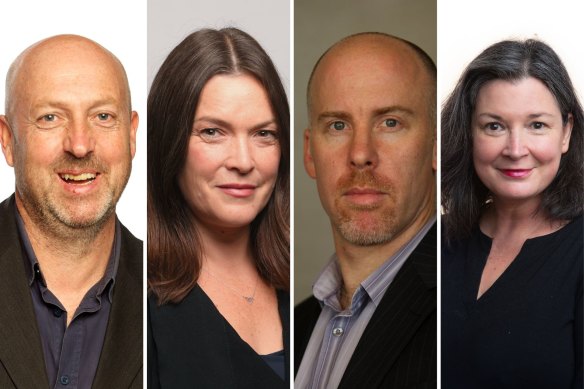
Some of the faces of The Age: Chief football writer Jake Niall, Good Weekend features writer Melissa Fyfe, investigative reporter and former deputy editor Michael Bachelard, and former editor Gay Alcorn.Credit: Simon Schluter, Eddie Jim, Ken Irwin
When I walked into The Age in 2006 – aged 25, and as green as I was hungry to make a difference – I was surrounded by journalists whom I’d read as a kid. To me, they were giants. Suddenly, they were my colleagues.
I came to work a week early, desperate to start. The legendary former Europe correspondent Simon Mann, who had taught me about the Balkans conflict through his reporting, sat a few metres away, acerbic, silver-haired and handsome.
The best crime writer in the country, John “Sly” Silvester, eyed me warily from a distance.
One of the doyens of the federal parliament press gallery, Michael Gordon, introduced himself quietly.
Gay Alcorn, a beautiful writer and fine reporter, as talented as she was frenetic, was introduced as my first boss. Gay would later become one of The Age’s best editors and the first woman to helm the masthead.
“Can you not bring your surfboard into the office?” Gay asked me in my first week.
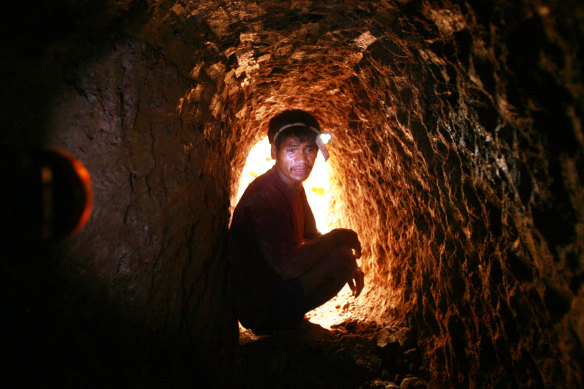
A miner in Didipio, Phillippines, where Melbourne-based company OceanaGold planned to dig up $3.6 billion worth of gold and copper from beneath a hill overlooking the village. Photographer Jason South took the pictures on Nick McKenzie’s first overseas assignment.Credit: Jason South
Shaun Carney, whose words could capture the essence of music with the same flair with which he wrote about politics, sat across the way. Young gun reporters Melissa Fyfe and Michael Bachelard perched nearby, along with the reporters who would, in time, form their own formidable reputations: Royce Millar, Ben Schneiders, Jewel Topsfield, Cameron Houston and so on.
Photographer Jason South, who almost died for his job in East Timor and whose photos I would search for in the paper as a teen, travelled with me on my first overseas assignment. South almost died a second time when he learnt that, to keep within budget, we’d be sleeping on the floor of a church in the Philippines. He booked something nicer but still ate the raw chicken that the villagers butchered and served us for breakfast.
In my first year at The Age, I once came across Mann cutting out his articles and sticking them into a scrapbook. “Once we are gone, it’s all we leave behind,” he quietly told me.
It stayed with me as a mark of pride in one’s work as a journalist and the fact The Age was a paper where serious reporters wanted to work.
I was recruited to the investigative unit by the mercurial editor Andrew Jaspan, who could tell you on Monday to investigate torture at Guantanamo Bay, and a day later pass on a tip about local council corruption. Desperate to make a mark, I reminded myself daily that the phone I now manned had once been answered by The Age’s investigative legends: Bill Birnbauer, who exposed big tobacco; David Wilson, who broke the famous Age Tapes series; and Gerard Ryle, who as head of the International Consortium of Investigative Journalists would break the Panama Papers story and win a Pulitzer.
It wasn’t merely their work ethic that made the trio great story-breakers.
The Age backed their tough, difficult journalism, just as it did when Andrew Rule, backed by editor Michael Gawenda, won the Gold Walkley for exposing the sexual predation of Indigenous leader Geoff Clark. Twenty-five years later, editor Patrick Elligett helmed our coverage of the CFMEU with the same resolve. Both stories shook the Australian polity, revealing deep abuses of power.
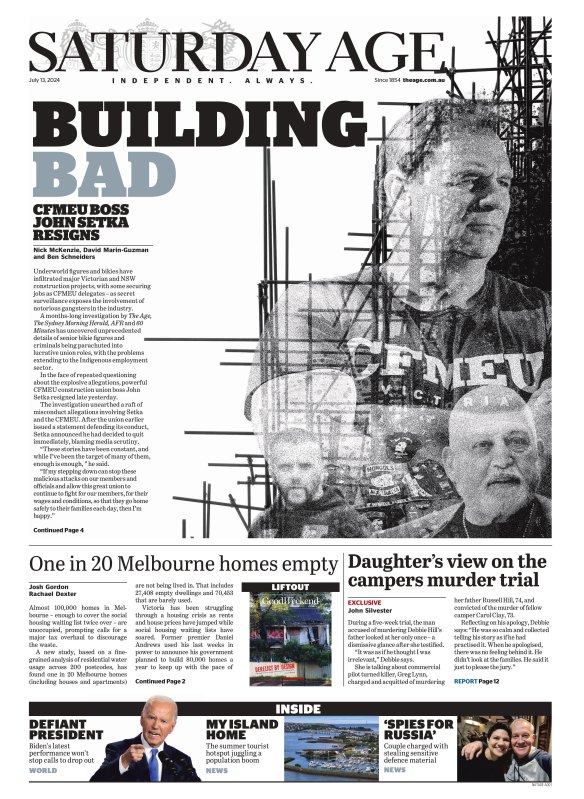
The Building Bad investigation sparked the resignation of CFMEU boss John Setka as the first front page of the series went to press.Credit: The Age
But neither could have been produced without The Age: from senior editors like Elligett and Dunckley, beat and desk editors, reporters, library researchers, diligent subeditors, tough lawyers (for decades it has been Peter Bartlett and David Poulton of MinterEllison), snappers, designers.
For the first decade of my career, I worked alongside the brilliant Richard Baker. Our bylines replicated the corporate law firm Baker McKenzie, and we would joke that while we would never get paid as much as a lawyer, we were in court just as often. Baker was by my side when, after we exposed the Reserve Bank’s involvement in a global corruption scandal, we were hauled before the County Court to reveal sources. After we refused and were ordered back to court, our lawyer told us to prepare a jail-clothes pack that didn’t include Nikes (which apparently would be swiftly purloined upon remand). We stayed staunch, protected our sources and avoided jail, and our story led to Australia’s first foreign bribery prosecution and the overhaul of corporate corruption laws. I doubt the then RBA governor Glenn Stevens has ever forgiven us.
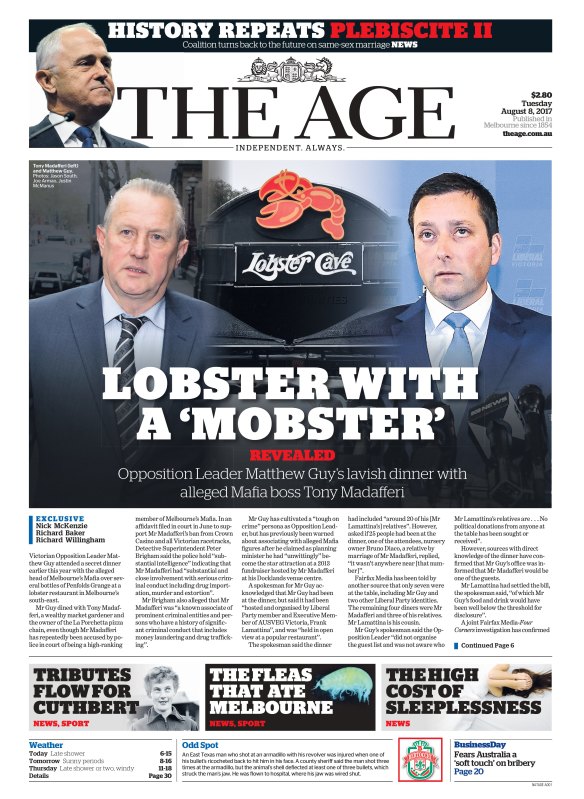
The story with the memorable headline that got Matthew Guy in hot water.Credit: The Age
We kept on uncovering things: a mafia Liberal Party donations scandal that implicated coalition ministers; the Unaoil international bribery affair (that led to investigations by the FBI, UK and European authorities, sent multiple businessmen to jail and produced over $1 billion in corporate fines); a police scandal that toppled a commissioner; abuse in the Catholic Church and in disabled care homes – stories that sparked parliamentary inquiries and, ultimately, a royal commission.
While Baker and I shared the bylines, it was our colleagues who made our work shine. I awoke one morning to discover a talented editor and journalist, Fergus Shiel, had quietly penned a headline for our story about then Liberal opposition leader Matthew Guy’s seafood dinner with a reputed mafia boss and political donor. The story faded, the headline didn’t: Lobster with a Mobster. Trades Hall bought a red lobster suit and sent its wearer to Coalition events. Guy never fully recovered.
When the AFL doping scandal blew up, Baker and I teamed up with footy journalism legends Caroline Wilson and Jake Niall. We pooled our sources, argued endlessly over copy, but ultimately exposed Essendon’s dreadful treatment of its young footballers. Bomber diehards have definitely never forgiven us.
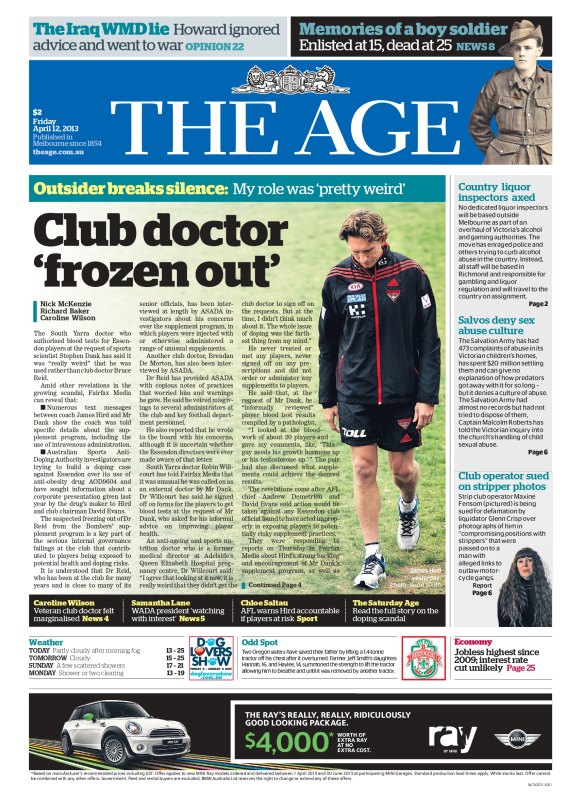
One of The Age’s front pages during the Essendon doping saga of 2013.Credit: The Age
At the heart of every great story is usually an unsung whistleblower. So it was when The Age teamed up with Four Corners in a pioneering move to produce cross-platform investigations, including a major piece on Beijing’s interference in Australian political affairs that cost Sam Dastyari his political career and triggered legislative reform that was copied around the world. The man who helped me reveal that story met me in a hotel room wearing a mask. He only spoke after he placed my phone in the fridge. This man literally risked his life to expose the truth. So did those who went deep undercover to help us expose neo-Nazis and sex traffickers.
The biggest stories caused major blowback, including calls to the board and pressure on editors. Neither flinched. Not once since joining The Age has a story been pulled. Since The Age started collaborating with 60 Minutes, we have exposed corruption within Crown Resorts and then Star, forcing royal commissions and reform around Australia. The board of Crown ran full-page advertisements bagging my reporting. The chair of Crown later apologised on oath.
The Age, and then 60 Minutes, helped Chris Masters and I expose war criminal Ben Roberts-Smith. The Age stood by us when, backed by an arrogant and out-of-touch billionaire, Roberts-Smith sued us, only to suffer a historic loss. The impact of that story continues to reverberate.
When I walk into the newsroom today, I do so with the same determination that I had in 2006. Faces have changed; editors and reporters have come and gone as the industry has contracted. But the new young guns are as good as I’ve ever seen: Charlotte Grieve, Paul Sakkal, Sumeyya Ilanbey. New recruits, such as Carla Jaeger, are emerging as stars.
Clever recruiting and editing has bolstered our ranks with huge talents, like crime reporter Chris Vedelago and state political editor Annika Smethurst. The legacy of Michael Gordon, who died too young, is carried on by David Crowe and James Massola and their colleagues in Canberra.
Those from my first shift in 2006, and who became senior editors, have reinvented themselves by returning to reporting or writing, like Gold Walkley winner Michael Bachelard, and Melissa Fyfe, who is now an acclaimed Good Weekend feature writer. Gay Alcorn will soon return as a senior writer. The list goes on.
As individuals, and as a team, today we continue the traditions of the hard-working Age journalists before us, committed to writing stories of local and global significance. There is more to come.
I doubt any of my colleagues cut out their articles like Simon Mann once did. But the feeling that fuels The Age’s newsroom is the same. I feel intensely privileged to be a journalist working for you – our readers and the public. My colleagues and I will keep taking risks and copping threats in the search for information you deserve to know. It’s what we, and The Age, do.
Start the day with a summary of the day’s most important and interesting stories, analysis and insights. Sign up for our Morning Edition newsletter.